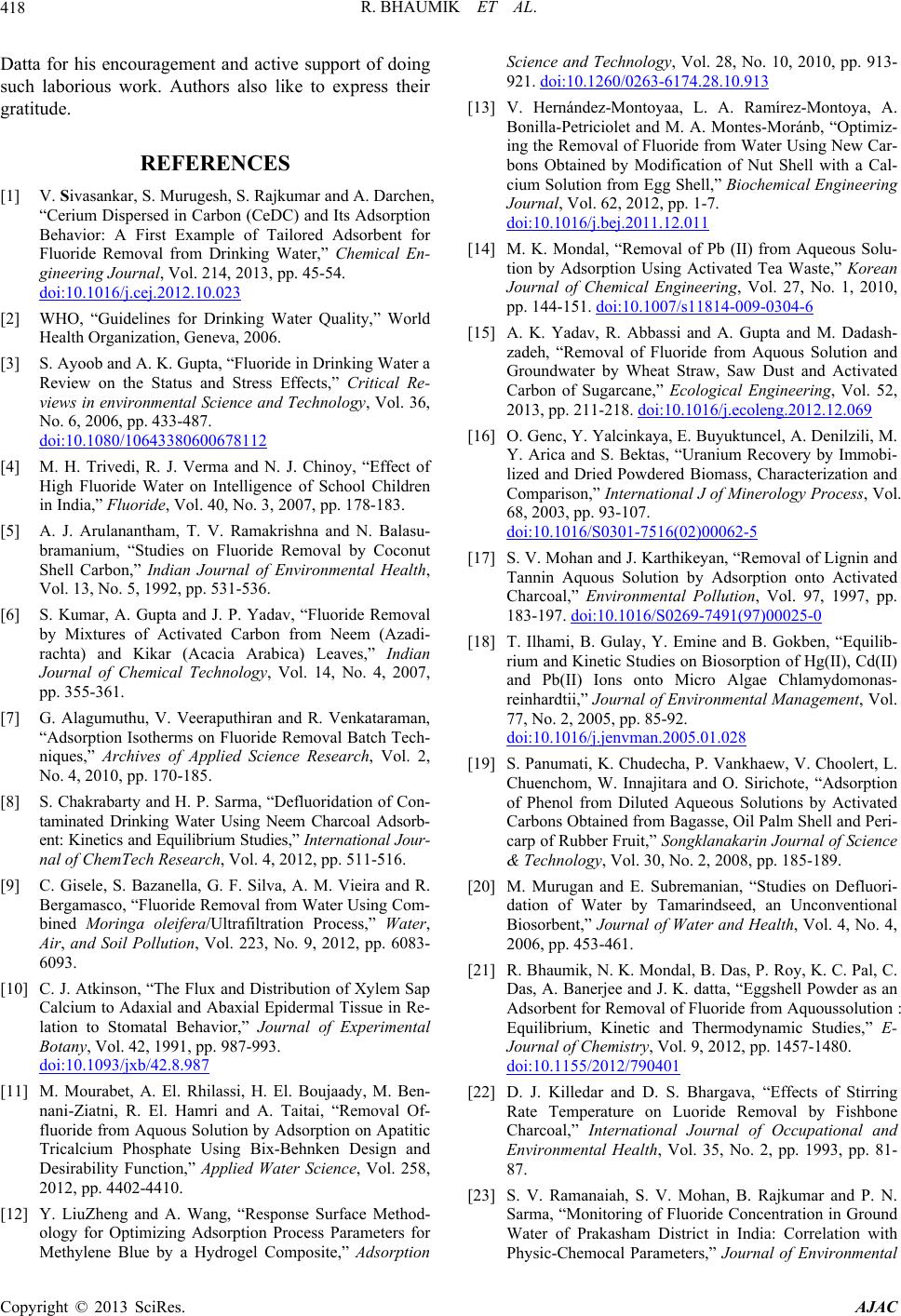
R. BHAUMIK ET AL.
418
Datta for his encouragement and active support of doing
such laborious work. Authors also like to express their
gratitude.
REFERENCES
[1] V. Sivasankar, S. Murugesh, S. Rajkumar and A. Darchen,
“Cerium Dispersed in Carbon (CeDC) and Its Adsorption
Behavior: A First Example of Tailored Adsorbent for
Fluoride Removal from Drinking Water,” Chemical En-
gineering Journal, Vol. 214, 2013, pp. 45-54.
doi:10.1016/j.cej.2012.10.023
[2] WHO, “Guidelines for Drinking Water Quality,” World
Health Organization, Geneva, 2006.
[3] S. Ayoob and A. K. Gupta, “Fluoride in Drinking Water a
Review on the Status and Stress Effects,” Critical Re-
views in environmental Science and Technology, Vol. 36,
No. 6, 2006, pp. 433-487.
doi:10.1080/10643380600678112
[4] M. H. Trivedi, R. J. Verma and N. J. Chinoy, “Effect of
High Fluoride Water on Intelligence of School Children
in India,” Fluoride, Vol. 40, No. 3, 2007, pp. 178-183.
[5] A. J. Arulanantham, T. V. Ramakrishna and N. Balasu-
bramanium, “Studies on Fluoride Removal by Coconut
Shell Carbon,” Indian Journal of Environmental Health,
Vol. 13, No. 5, 1992, pp. 531-536.
[6] S. Kumar, A. Gupta and J. P. Yadav, “Fluoride Removal
by Mixtures of Activated Carbon from Neem (Azadi-
rachta) and Kikar (Acacia Arabica) Leaves,” Indian
Journal of Chemical Technology, Vol. 14, No. 4, 2007,
pp. 355-361.
[7] G. Alagumuthu, V. Veeraputhiran and R. Venkataraman,
“Adsorption Isotherms on Fluoride Removal Batch Tech-
niques,” Archives of Applied Science Research, Vol. 2,
No. 4, 2010, pp. 170-185.
[8] S. Chakrabarty and H. P. Sarma, “Defluoridation of Con-
taminated Drinking Water Using Neem Charcoal Adsorb-
ent: Kinetics and Equilibrium Studies,” International Jour-
nal of ChemTech Research, Vol. 4, 2012, pp. 511-516.
[9] C. Gisele, S. Bazanella, G. F. Silva, A. M. Vieira and R.
Bergamasco, “Fluoride Removal from Water Using Com-
bined Moringa oleifera/Ultrafiltration Process,” Water,
Air, and Soil Pollution, Vol. 223, No. 9, 2012, pp. 6083-
6093.
[10] C. J. Atkinson, “The Flux and Distribution of Xylem Sap
Calcium to Adaxial and Abaxial Epidermal Tissue in Re-
lation to Stomatal Behavior,” Journal of Experimental
Botany, Vol. 42, 1991, pp. 987-993.
doi:10.1093/jxb/42.8.987
[11] M. Mourabet, A. El. Rhilassi, H. El. Boujaady, M. Ben-
nani-Ziatni, R. El. Hamri and A. Taitai, “Removal Of-
fluoride from Aquous Solution by Adsorption on Apatitic
Tricalcium Phosphate Using Bix-Behnken Design and
Desirability Function,” Applied Water Science, Vol. 258,
2012, pp. 4402-4410.
[12] Y. LiuZheng and A. Wang, “Response Surface Method-
ology for Optimizing Adsorption Process Parameters for
Methylene Blue by a Hydrogel Composite,” Adsorption
Science and Technology, Vol. 28, No. 10, 2010, pp. 913-
921. doi:10.1260/0263-6174.28.10.913
[13] V. Hernández-Montoyaa, L. A. Ramírez-Montoya, A.
Bonilla-Petriciolet and M. A. Montes-Moránb, “Optimiz-
ing the Removal of Fluoride from Water Using New Car-
bons Obtained by Modification of Nut Shell with a Cal-
cium Solution from Egg Shell,” Biochemical Engineering
Journal, Vol. 62, 2012, pp. 1-7.
doi:10.1016/j.bej.2011.12.011
[14] M. K. Mondal, “Removal of Pb (II) from Aqueous Solu-
tion by Adsorption Using Activated Tea Waste,” Korean
Journal of Chemical Engineering, Vol. 27, No. 1, 2010,
pp. 144-151. doi:10.1007/s11814-009-0304-6
[15] A. K. Yadav, R. Abbassi and A. Gupta and M. Dadash-
zadeh, “Removal of Fluoride from Aquous Solution and
Groundwater by Wheat Straw, Saw Dust and Activated
Carbon of Sugarcane,” Ecological Engineering, Vol. 52,
2013, pp. 211-218. doi:10.1016/j.ecoleng.2012.12.069
[16] O. Genc, Y. Yalcinkaya, E. Buyuktuncel, A. Denilzili, M.
Y. Arica and S. Bektas, “Uranium Recovery by Immobi-
lized and Dried Powdered Biomass, Characterization and
Comparison,” International J of Minerology Process, Vol.
68, 2003, pp. 93-107.
doi:10.1016/S0301-7516(02)00062-5
[17] S. V. Mohan and J. Karthikeyan, “Removal of Lignin and
Tannin Aquous Solution by Adsorption onto Activated
Charcoal,” Environmental Pollution, Vol. 97, 1997, pp.
183-197. doi:10.1016/S0269-7491(97)00025-0
[18] T. Ilhami, B. Gulay, Y. Emine and B. Gokben, “Equilib-
rium and Kinetic Studies on Biosorption of Hg(II), Cd(II)
and Pb(II) Ions onto Micro Algae Chlamydomonas-
reinhardtii,” Journal of Environmental Management, Vol.
77, No. 2, 2005, pp. 85-92.
doi:10.1016/j.jenvman.2005.01.028
[19] S. Panumati, K. Chudecha, P. Vankhaew, V. Choolert, L.
Chuenchom, W. Innajitara and O. Sirichote, “Adsorption
of Phenol from Diluted Aqueous Solutions by Activated
Carbons Obtained from Bagasse, Oil Palm Shell and Peri-
carp of Rubber Fruit,” Songklanakarin Journal of Science
& Technology, Vol. 30, No. 2, 2008, pp. 185-189.
[20] M. Murugan and E. Subremanian, “Studies on Defluori-
dation of Water by Tamarindseed, an Unconventional
Biosorbent,” Journal of Water and Health, Vol. 4, No. 4,
2006, pp. 453-461.
[21] R. Bhaumik, N. K. Mondal, B. Das, P. Roy, K. C. Pal, C.
Das, A. Banerjee and J. K. datta, “Eggshell Powder as an
Adsorbent for Removal of Fluoride from Aquoussolution :
Equilibrium, Kinetic and Thermodynamic Studies,” E-
Journal of Chemistry, Vol. 9, 2012, pp. 1457-1480.
doi:10.1155/2012/790401
[22] D. J. Killedar and D. S. Bhargava, “Effects of Stirring
Rate Temperature on Luoride Removal by Fishbone
Charcoal,” International Journal of Occupational and
Environmental Health, Vol. 35, No. 2, pp. 1993, pp. 81-
87.
[23] S. V. Ramanaiah, S. V. Mohan, B. Rajkumar and P. N.
Sarma, “Monitoring of Fluoride Concentration in Ground
Water of Prakasham District in India: Correlation with
Physic-Chemocal Parameters,” Journal of Environmental
Copyright © 2013 SciRes. AJAC